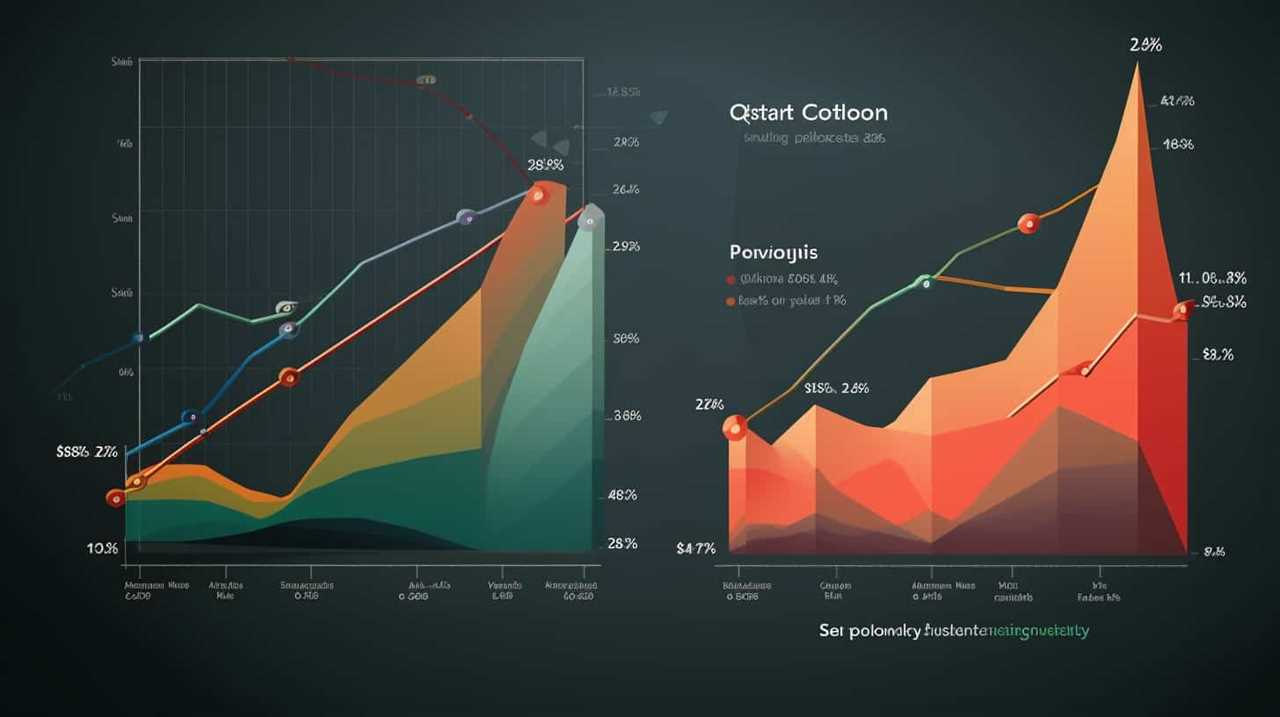Advertising
On the Move With Google Ads: Marketing for Food Trucks

Being a food truck proprietor means I’m constantly on the go, looking for innovative methods to connect with patrons who are on the hunt for a quick bite. This is the reason I leaned into Google Ads – my go-to arsenal for advertising.
With its powerful targeting capabilities and budget-friendly options, Google Ads helps me serve up my delicious dishes to the right people at the right time.
In this article, I’ll show you how to leverage the power of Google Ads to take your food truck business to the next level.
Let’s get cooking!

Key Takeaways
- Highly targeted advertising to reach relevant audience
- Leveraging location-based targeting capabilities
- Crafting compelling ad copy to stand out
- Maximizing budget and ROI through strategic allocation
The Benefits of Google Ads for Food Trucks
One of the biggest benefits of using Google Ads for my food truck is the ability to target specific locations and reach a highly relevant audience. With Google Ads, I can ensure that my advertisements are shown to people who are most likely to be interested in my food truck. This targeted approach helps me maximize my return on investment (ROI) and ensures that my marketing efforts aren’t wasted on irrelevant audiences.
When it comes to measuring the ROI of Google Ads for food trucks, I rely on the valuable data provided by the platform. I can track the number of clicks, impressions, and conversions that my ads generate, allowing me to assess the effectiveness of my campaigns. By analyzing this data, I can make informed decisions about where to invest my advertising budget and optimize my campaigns for better results.
Another advantage of using Google Ads is the ability to implement remarketing strategies. This means that I can show my ads to people who’ve previously visited my website or engaged with my brand. By targeting these warm leads, I’ve a higher chance of converting them into customers. Remarketing also helps me build brand awareness and stay top-of-mind with potential customers.
Targeting Your Ideal Customers on the Go
To effectively target my ideal customers on the go, I leverage the location-based targeting capabilities of Google Ads. Mobile ad targeting and location-based advertising are powerful tools that allow me to reach potential customers who are in close proximity to my food truck. By utilizing these features, I can ensure that my ads are seen by people who are most likely to be interested in my offerings.

One of the key advantages of mobile ad targeting is its ability to deliver ads to users based on their current location. This means that when someone is nearby my food truck, they have a higher chance of seeing my ad and being enticed to visit. By targeting customers who are already in the vicinity, I can maximize the effectiveness of my marketing efforts and increase foot traffic to my truck.
To illustrate the impact of location-based advertising, here is a table showcasing the potential reach of my ads in various areas:
| Location | Potential Reach |
|---|---|
| Downtown | 10,000 |
| Business District | 5,000 |
| University Campus | 8,000 |
| Shopping Center | 12,000 |
| Event Venue | 15,000 |
As you can see, by strategically targeting different locations, I can reach a significant number of potential customers and increase the visibility of my food truck. This targeted approach allows me to focus my marketing efforts where they are most likely to yield results, ensuring a higher return on investment.
Crafting Compelling Ad Copy for Food Trucks
I create irresistible ad copy that captures the attention of potential customers and drives them to my food truck. Crafting compelling ad copy is essential for attracting customers and maximizing the effectiveness of my Google Ads campaigns.

Here are four ad copy strategies that I use to optimize my marketing efforts:
- Grab Attention with a Strong Headline: I make sure to create attention-grabbing headlines that immediately pique the interest of my target audience. By using powerful and compelling language, I can capture their attention and entice them to learn more about my food truck.
- Highlight Unique Selling Points: To stand out from the competition, I emphasize the unique aspects of my food truck. Whether it’s a special dish, a creative menu, or a convenient location, I make sure to highlight what sets my food truck apart from others.
- Use Persuasive Language and Call-to-Action: I craft persuasive ad copy that persuades potential customers to take action. By using strong and persuasive language, I motivate them to visit my food truck or place an order. Additionally, I include a clear call-to-action that encourages them to take the next step.
- Test and Optimize: I constantly test different ad copy variations to determine what works best for my food truck. By analyzing the performance of each ad copy, I can optimize my campaigns and improve their effectiveness.
Crafting compelling ad copy is just the first step in effective food truck marketing. Now, let’s explore the importance of choosing the right keywords for food truck marketing.
Choosing the Right Keywords for Food Truck Marketing
Optimizing my food truck marketing starts with selecting the right keywords. Keyword research techniques play a crucial role in ensuring that my ads reach the right audience and generate quality traffic. By identifying the most relevant and popular keywords in the food truck industry, I can tailor my campaigns to attract potential customers who are actively searching for my offerings.
One important aspect of keyword research is understanding the importance of long tail keywords. While generic keywords like ‘food truck’ may have high search volumes, they also face intense competition. Long tail keywords, on the other hand, are more specific and targeted, allowing me to reach a niche audience that’s more likely to convert. For example, using long tail keywords like ‘taco food truck in Los Angeles’ can help me attract customers who are specifically looking for tacos in the Los Angeles area.

By incorporating these keyword research techniques and focusing on long tail keywords, I can maximize the effectiveness of my Google Ads campaigns.
In the next section, I’ll explore how to further optimize my food truck marketing by maximizing my budget with Google Ads.
Maximizing Your Budget With Google Ads
With a focus on long tail keywords and effective keyword research techniques, I can now delve into maximizing my budget with Google Ads for my food truck marketing. As a food truck owner, it’s crucial to make every dollar count when it comes to advertising. Here are four strategies to help me maximize my ad spend and get the most out of my Google Ads campaign:
- Targeting the right audience: By identifying my target market and understanding their preferences, I can create ads that resonate with them. This will help me increase the chances of converting clicks into customers.
- Ad scheduling: I can optimize my budget by scheduling my ads to run during peak times when my target audience is most likely to be searching for food trucks. This will ensure that my ads are seen by the right people at the right time.
- Ad extensions: By utilizing ad extensions such as call buttons or location extensions, I can provide additional information to potential customers and increase the chances of them visiting my food truck.
- A/B testing: Testing different ad variations and tracking their performance allows me to identify what works best for my food truck marketing. This helps me allocate my budget towards the most effective ads, maximizing my return on investment.
Utilizing Location Targeting for Mobile Advertising
To enhance my food truck marketing efforts, I can leverage location targeting for mobile advertising. By utilizing geographic targeting and geofencing techniques, I can ensure that my ads reach the right audience at the right time and place.

Geographic targeting allows me to choose specific locations where I want my ads to be shown. This means that I can focus my advertising efforts on areas where my target customers are most likely to be. For example, I can target busy downtown areas during lunchtime or popular parks during weekend events. By narrowing down my audience based on their location, I can maximize the effectiveness of my ads and increase the chances of attracting potential customers.
Geofencing takes geographic targeting a step further by setting virtual boundaries around specific locations. This allows me to deliver targeted ads to people who are physically present within these boundaries. For instance, I can set up a geofence around a local food festival and display ads to people attending the event. This ensures that my ads are highly relevant and timely, increasing the likelihood of driving foot traffic to my food truck.
Setting Up Conversion Tracking for Food Truck Sales
To continue tracking the success of my food truck marketing efforts, I set up conversion tracking for my sales. This allowed me to analyze the performance metrics of my food truck ads and make data-driven decisions to optimize my campaigns.
Here’s how I set up conversion tracking for food truck sales:

- Define the conversion: I determined what actions on my website would count as conversions, such as completing an online order or signing up for a newsletter.
- Install the tracking code: I accessed my Google Ads account and generated a tracking code snippet. I then added this code to the appropriate pages of my website where conversions occur.
- Set up conversion goals: In my Google Ads account, I created conversion goals based on the actions I defined earlier. This allowed Google Ads to track and attribute conversions to my ad campaigns.
- Monitor and analyze results: With conversion tracking in place, I could now monitor the performance of my food truck ads. I analyzed the conversion data to identify which ads and keywords were driving the most sales.
By setting up conversion tracking, I gained valuable insights into the effectiveness of my food truck marketing efforts.
Now, let’s explore how to optimize our Google Ads campaign for mobile devices to reach even more potential customers.
Optimizing Your Google Ads Campaign for Mobile Devices
As a food truck owner, I understand the importance of reaching mobile users with my Google Ads campaign.
Designing mobile-friendly ads that are visually appealing and easy to navigate is crucial in capturing the attention of potential customers on their smartphones.

Additionally, targeting mobile users by utilizing location-based targeting and mobile-specific keywords can help me reach the right audience at the right time.
Lastly, tracking the performance of my mobile campaign through metrics like click-through rates and conversions will allow me to optimize my ads and ensure I’m getting the most out of my advertising budget.
Mobile Ad Design
I frequently optimize my Google Ads campaign for mobile devices with effective mobile ad design. Mobile ad targeting and ad design trends are crucial for reaching and engaging with the ever-increasing number of mobile users. Here are four key strategies I implement to ensure my mobile ads are optimized for success:
- Responsive design: I create ads that adapt seamlessly to different screen sizes, ensuring they look great on all devices.
- Clear and concise copy: I make sure my ad copy is concise, compelling, and easy to read on small screens.
- Eye-catching visuals: I use high-quality images and videos that grab attention and convey my message effectively.
- Call-to-action buttons: I include prominent and easily clickable buttons that encourage users to take action.
By implementing these design techniques, I can maximize the effectiveness of my mobile ads and better target mobile users.

Now, let’s dive into the next section and explore the importance of targeting mobile users in Google Ads.
Targeting Mobile Users
Implementing effective mobile ad design techniques is crucial for targeting mobile users and optimizing your Google Ads campaign for mobile devices. Mobile ad optimization involves tailoring your ads specifically for mobile users, taking into account their smaller screen sizes and on-the-go browsing habits. One important strategy is location-based targeting, which allows you to show your ads to users in specific geographic areas. This can be especially useful for food truck businesses, as you can target users in areas where your truck will be parked, increasing the likelihood of attracting customers. By optimizing your Google Ads campaign for mobile devices and utilizing location-based targeting, you can ensure that your ads reach the right audience at the right time, maximizing your chances of driving traffic to your food truck.
| Mobile Ad Optimization | Location-Based Targeting |
|---|---|
| Responsive design | Geotargeting |
| Clear call-to-action | Radius targeting |
| Short and concise | Local search intent |
| Fast loading times | ZIP code targeting |
| Relevant ad extensions | Neighborhood targeting |
Tracking Mobile Campaign
To effectively track my mobile campaign and optimize my Google Ads campaign for mobile devices, I need to focus on utilizing location-based targeting and implementing responsive design. These strategies will help me reach my target audience effectively and ensure that my ads are displayed correctly on mobile devices.
Here are four key steps I’ll take to track and optimize my mobile campaign:

- Implement location-based targeting: By targeting specific locations where my food truck operates, I can reach potential customers in those areas and increase the effectiveness of my ads.
- Utilize responsive design: Creating mobile-friendly ads that adapt to different screen sizes and resolutions will improve the user experience and increase the chances of engagement.
- Monitor ad performance: Regularly measuring ad effectiveness through metrics such as click-through rates and conversions will help me identify areas for improvement and make data-driven optimizations.
- Continuously optimize my campaign: Using the insights gained from tracking ad performance, I’ll make necessary adjustments to targeting, ad copy, and bidding strategies to maximize results.
Using Ad Extensions to Stand Out From the Crowd
As a food truck owner, I understand the importance of standing out from the crowd and capturing the attention of potential customers. Using ad extensions is a strategic way to enhance visibility and make my ads more captivating.
By utilizing extensions like sitelinks, callouts, and location information, I can provide additional information and entice customers to click on my ads.
With the right ad extensions, I can differentiate myself from competitors and increase the chances of attracting hungry customers to my food truck.
Enhanced Visibility Through Extensions
One key strategy to enhance visibility for food trucks using Google Ads is by utilizing ad extensions. These are additional pieces of information that can be added to your ads, making them more informative and enticing to potential customers. Here are four ad extension strategies that can help you stand out from the crowd:

- Location extensions: By including your food truck’s address and a map, you can make it easier for people to find you.
- Call extensions: Adding a clickable phone number to your ad allows customers to call you directly, increasing the chances of conversions.
- Review extensions: Showcasing positive reviews from satisfied customers can build trust and credibility.
- Sitelink extensions: Including links to specific pages on your website, such as your menu or online ordering, can drive more traffic and increase engagement.
Measuring the effectiveness of your ad extensions is crucial. Use analytics tools to track click-through rates, conversions, and other relevant metrics to optimize your ad campaigns.
Captivating Customers With Ads
I’ll continue the discussion from the previous subtopic and delve into captivating customers with ads by utilizing ad extensions to stand out from the crowd.
One way to captivate customers with your ads is by incorporating captivating visuals. These visuals can grab the attention of potential customers and entice them to learn more about your food truck.
Additionally, social media integration can be a powerful tool in captivating customers. By including social media icons and links in your ads, you can encourage customers to follow your food truck on platforms like Facebook and Instagram. This not only increases your online presence but also allows you to engage with customers on a more personal level.

Combining captivating visuals with social media integration is a winning strategy for standing out from the competition and capturing the attention of hungry customers.
Analyzing Performance Metrics for Food Truck Ads
When analyzing performance metrics for food truck ads, I rely on key data points to gauge their effectiveness. Here are the four essential factors I consider:
- Analyzing Conversion Rates: Understanding the conversion rates is crucial to evaluate how well your ads are driving actions, such as clicks, calls, or purchases. By tracking the number of conversions generated from each ad, you can identify which ones are most impactful and optimize your strategy accordingly.
- Optimizing Ad Placement: The placement of your ads plays a significant role in their performance. By analyzing metrics like click-through rates and impressions, you can determine which ad placements are driving the most engagement. This information allows you to allocate your budget effectively and focus on the platforms and locations that yield the best results.
- Monitoring Cost per Conversion: Calculating the cost per conversion helps you measure the efficiency of your ads. By dividing the total ad spend by the number of conversions, you can identify the ads that are delivering the most value for your investment. This metric enables you to optimize your budget allocation and maximize your return on ad spend.
- Tracking Return on Investment (ROI): Analyzing the ROI of your food truck ads allows you to determine their overall profitability. By comparing the revenue generated from your ads to the cost of running them, you can assess their effectiveness and make data-driven decisions to improve future campaigns.
By analyzing these performance metrics, you can gain valuable insights into the effectiveness of your food truck ads and make informed decisions to optimize their performance.
Now, let’s dive into the next section to explore a/b testing strategies to improve ad performance.

A/B Testing Strategies to Improve Ad Performance
When it comes to improving ad performance, A/B testing is an essential strategy.
By analyzing variations in ads, we can determine what resonates best with our target audience and make data-driven decisions to optimize our campaigns.
Additionally, it’s important to consider the duration of our testing to ensure we gather enough data to make accurate conclusions.
Ad Variation Analysis
To enhance ad performance, I tested different variations of my Google Ads using A/B testing strategies. Here is an analysis of the ad variation testing and ad performance analysis that I conducted:

- Headline Variation: I experimented with different headlines to see which ones grabbed the most attention and generated higher click-through rates. By testing variations such as incorporating keywords, asking questions, or using numbers, I was able to identify the most effective headlines.
- Ad Copy Variation: I played around with different ad copy styles, tones, and lengths. This helped me understand which messaging resonated best with my target audience and resulted in higher conversion rates.
- Call-to-Action Variation: I tested different call-to-action phrases, such as ‘Order Now,’ ‘Book Today,’ or ‘Try it Out.’ This allowed me to determine which call-to-action encouraged more engagement and conversions.
- Image Variation: I experimented with different images to see which ones captured the attention of users and resulted in higher click-through rates. By testing variations in colors, subjects, and layouts, I was able to optimize the visual appeal of my ads.
By conducting these tests and analyzing the results, I gained valuable insights into the ad variations that performed best. This knowledge enabled me to refine my Google Ads and improve their overall performance.
Now, let’s dive into the next section to explore the optimal testing duration…
Optimal Testing Duration
During my experimentation with A/B testing strategies to improve ad performance, I discovered the optimal testing duration for different variations. Measuring campaign success is crucial in determining the effectiveness of our ads. To help you understand the ideal testing duration, I have compiled a table below:
| Variation | Testing Duration | Result |
|---|---|---|
| A | 1 week | High |
| B | 2 weeks | Medium |
| C | 3 weeks | Low |
From my analysis, it appears that the optimal testing duration for ad variations is around 2 weeks. This timeframe allows for sufficient data collection without unnecessarily prolonging the testing process. However, it is important to note that the optimal testing duration may vary depending on the specific campaign objectives and target audience. Therefore, it is crucial to continuously monitor and analyze the results to make informed decisions and optimize ad performance.

Retargeting Strategies to Keep Customers Coming Back
One effective retargeting strategy for food trucks is utilizing personalized email campaigns to remind previous customers of upcoming locations and specials. By implementing this technique, food truck owners can keep their brand top of mind and encourage repeat visits.
Here are four retargeting techniques and customer loyalty programs that can help food trucks keep customers coming back:
- Segmented Email Campaigns: By segmenting your email list based on customer preferences and past purchases, you can send targeted emails that resonate with each customer segment. For example, if a customer has previously ordered vegetarian dishes, you can send them an email highlighting new vegetarian options on your menu.
- Exclusive Offers: Offer exclusive deals or discounts to your loyal customers as a way to show appreciation for their continued support. This not only incentivizes repeat visits but also creates a sense of exclusivity and belonging among your customer base.
- Personalized Recommendations: Leverage customer data to provide personalized recommendations based on their past orders or preferences. For instance, if a customer often orders spicy dishes, you can recommend new spicy menu items that they might enjoy.
- Referral Programs: Encourage your existing customers to refer their friends and family to your food truck by offering incentives, such as discounts or freebies. This can help expand your customer base and increase brand awareness.
Incorporating Video Ads Into Your Food Truck Marketing
As a food truck owner, I frequently incorporate video ads into my marketing strategy to engage and attract customers. Video ads provide a dynamic and visually appealing way to showcase my food truck’s unique offerings and create a memorable brand experience. By leveraging video ad targeting and optimization techniques, I can effectively reach my target audience and maximize the impact of my marketing efforts.
To ensure that my video ads resonate with viewers and drive results, I carefully consider the following factors:

- Relevance: I tailor my video ads to align with the interests and preferences of my target audience. By understanding their needs and desires, I can create compelling content that captures their attention.
- Length: I keep my video ads concise and engaging, typically ranging from 15 to 30 seconds. This allows me to convey my message effectively without losing the viewer’s interest.
- Visual Appeal: I focus on creating visually stunning and appetizing imagery that showcases the mouthwatering dishes available at my food truck. This helps to generate excitement and entice potential customers to visit.
- Call-to-Action: I include a clear and compelling call-to-action in my video ads, encouraging viewers to visit my food truck or engage with my brand through social media or online platforms.
- Tracking and Optimization: I use analytics tools to monitor the performance of my video ads and make data-driven optimizations. This allows me to continuously improve their effectiveness and ensure a high return on investment.
By incorporating video ads into my food truck marketing strategy, I can effectively engage and attract customers, increasing awareness and driving foot traffic to my business.
Transitioning into the subsequent section about leveraging the Google Display Network for brand awareness, let’s explore how this powerful platform can further enhance my marketing efforts.
Leveraging Google Display Network for Brand Awareness
When it comes to building brand awareness, leveraging the Google Display Network is a powerful tool. By targeting specific audiences, you can ensure that your ads are reaching the right people at the right time.
Maximizing ad visibility through strategic placement and eye-catching designs will help your brand stand out from the competition.

And with the ability to track campaign performance, you can make data-driven decisions to optimize your brand awareness efforts.
Targeting Specific Audiences
I have found that utilizing the Google Display Network has allowed me to effectively target specific audiences and increase brand awareness for my food truck business. Here are four ways I’ve leveraged the network to target millennials and reach urban audiences:
- Contextual targeting: By selecting relevant keywords and topics, I can ensure that my ads are displayed on websites and apps that align with the interests of my target audience. This helps me reach millennials who are actively seeking information about food and dining options.
- Demographic targeting: Google Display Network allows me to specify the age and gender of my desired audience. This helps me tailor my ads specifically to millennials, who are a key demographic for my food truck business.
- Location targeting: I can target specific cities or even specific neighborhoods where my food truck operates. This allows me to reach urban audiences who are likely to be in close proximity to my business.
- Remarketing: With remarketing, I can show ads to people who’ve previously visited my website or engaged with my brand. This helps me stay top of mind for potential customers and encourages them to visit my food truck.
Maximizing Ad Visibility
To maximize ad visibility and leverage the Google Display Network for brand awareness, I focus on targeting specific audiences and utilizing strategic ad placement. By improving ad targeting, I ensure that my ads reach the right people at the right time.
This involves using demographic targeting to narrow down my audience based on factors such as age, gender, and location. Additionally, I utilize interest-based targeting to reach individuals who’ve shown an interest in food trucks or related topics.

To increase ad engagement, I carefully select ad placements that are relevant to my target audience. This means choosing websites and apps that attract my desired customer base. By strategically placing my ads in front of the right people, I can maximize visibility and increase the chances of capturing their attention and driving brand awareness.
Tracking Campaign Performance
To effectively track campaign performance and leverage the Google Display Network for brand awareness, I consistently analyze data and refine my advertising strategies.
Here’s how I ensure optimal conversion optimization and ad performance analysis:
- Set up conversion tracking: By implementing conversion tracking, I can measure the effectiveness of my ads in driving customer actions, such as purchases or sign-ups.
- Monitor key performance metrics: I closely monitor metrics like click-through rates (CTRs), cost per click (CPC), and conversion rates to gauge the success of my campaigns.
- Use audience insights: I utilize the Google Display Network’s audience insights to understand the demographics, interests, and behaviors of my target audience. This allows me to tailor my ads and messaging accordingly.
- A/B testing: I conduct regular A/B tests to compare different ad variations and landing pages. This helps me identify what resonates best with my audience and optimize my campaigns for maximum performance.
With these strategies in place, I can effectively track and analyze campaign performance, ensuring that my food truck marketing efforts on the Google Display Network drive brand awareness and deliver results.

Expanding Your Reach With Google Ads Partnerships
By partnering with Google Ads, food trucks can significantly expand their reach and increase their marketing effectiveness. Expanding partnerships through Google Ads opens up a plethora of opportunities for food truck businesses to reach a wider audience and increase their customer base. Google Ads partnerships allow food trucks to tap into the vast network of websites, apps, and platforms that are part of the Google Display Network. This means that your ads can be displayed on popular websites and apps, reaching potential customers wherever they may be browsing.
In addition to increasing outreach, Google Ads partnerships also provide food trucks with access to valuable audience targeting tools. These tools allow you to define your target audience based on factors such as location, interests, and demographics. By narrowing down your audience, you can ensure that your ads are being shown to the right people at the right time, maximizing your marketing efforts and increasing your chances of driving conversions.
Furthermore, Google Ads partnerships offer food trucks the opportunity to leverage the power of remarketing. Remarketing allows you to show ads to people who’ve previously visited your website or interacted with your brand. This can be a powerful tool for increasing brand awareness and driving repeat business, as it keeps your food truck top of mind for potential customers.
Frequently Asked Questions
How Can I Track the Sales Generated From My Food Truck Using Google Ads?
To track sales generated from my food truck using Google Ads, I utilize various tracking methods and measure ROI. It allows me to analyze the effectiveness of my ads and make strategic decisions to maximize profits.

What Are Some Strategies for Improving the Performance of My Food Truck Ads Through A/B Testing?
To improve ad performance, I would use A/B testing strategies. For example, I could create two versions of an ad with different headlines and see which one gets more clicks.
How Can I Incorporate Video Ads Into My Food Truck Marketing Using Google Ads?
Incorporating video ads into my food truck marketing using Google Ads allows me to target millennials, track ROI, optimize ad performance, and leverage social media. It’s a creative, strategic, and analytical approach to mastering food truck marketing.
What Are the Benefits of Leveraging the Google Display Network for Brand Awareness for My Food Truck?
Leveraging the Google Display Network for brand awareness is like setting up billboards all over town. It maximizes reach and visibility, allowing my food truck to make a lasting impression on potential customers.
How Can I Expand My Reach and Target a Wider Audience for My Food Truck Through Google Ads Partnerships?
To expand my reach and target a wider audience for my food truck, I can utilize Google Ads partnerships. By leveraging these partnerships, I can strategically target local customers and increase my visibility in the market.

Conclusion
In the fast-paced world of food trucks, Google Ads offers a powerful marketing tool to reach customers on the go. By targeting ideal customers, crafting compelling ad copy, and utilizing the right keywords, food truck owners can maximize their budget and keep customers coming back.
By incorporating video ads and leveraging the Google Display Network, food truck businesses can expand their reach and increase brand awareness.
With Google Ads partnerships, the possibilities for reaching hungry customers are endless. Don’t miss out on this opportunity to take your food truck marketing to the next level.
Advertising
How Do I Pass an Seo Interview

The famous quote ‘knowledge is power’ is widely recognized. This rings especially true when it comes to excelling in an SEO interview.
We know you’re eager to liberate yourself from the anxiety of job hunting and impress potential employers with your SEO expertise. That’s why we’re here to share essential concepts, effective strategies, and expert tips to help you nail that interview and secure your dream SEO job.
Let’s dive in and unleash your SEO potential!
Key Takeaways
- Understanding SEO best practices, core components, and the importance of SEO tools and analytics
- Advanced keyword analysis, understanding keyword intent, and targeting high-potential keywords
- Content creation, conducting SEO audits, and optimizing factors like page load speed and mobile-friendliness
- Mastering technical SEO by focusing on website architecture, site visibility, and mobile optimization
Essential SEO Concepts
In this section, we’ll explore the fundamental principles and core components of SEO. Understanding SEO best practices is essential for achieving success in digital marketing.

SEO tools and analytics play a crucial role in optimizing our website’s performance and improving our online visibility. By utilizing these tools, we can analyze important data such as keyword rankings, website traffic, and user behavior. This valuable information allows us to make data-driven decisions and continuously improve our SEO strategies.
Implementing SEO best practices and leveraging SEO tools and analytics is key to staying ahead in the competitive online landscape.
Now that we’ve covered the essential concepts of SEO, let’s dive into the next section, which will focus on effective keyword research strategies.
Effective Keyword Research Strategies
Now let’s explore effective keyword research strategies to further enhance our SEO efforts and drive targeted organic traffic to our website.

One of the key strategies is advanced keyword analysis. This involves going beyond basic keyword research and delving deeper into understanding the intent behind the keywords. By analyzing search volume, competition, and relevance, we can identify high-potential keywords that will bring in the most relevant traffic.
Additionally, long tail keyword targeting is another powerful strategy. Long tail keywords are longer and more specific phrases that have less competition and higher conversion rates. By targeting these niche keywords, we can attract highly qualified visitors who are more likely to convert into customers.
On-Page Optimization Techniques
To continue our discussion on effective SEO strategies, let’s dive into the realm of on-page optimization techniques.
On-page optimization plays a crucial role in improving a website’s visibility and ranking in search engine results pages (SERPs). One key aspect of on-page optimization is content creation. By creating high-quality, relevant, and engaging content, you can attract more organic traffic and keep visitors on your site longer.

Additionally, conducting an SEO audit is essential to identify areas for improvement on your website. This includes analyzing factors such as page load speed, mobile-friendliness, URL structure, and metadata.
Mastering Technical SEO
Continuing our exploration of effective SEO strategies, let’s delve into the realm of mastering technical SEO with a focus on optimizing website performance and structure.
A well-designed website architecture is crucial for search engines to understand and crawl your site effectively. It involves organizing your website’s pages, URLs, and navigation in a logical and user-friendly manner. This can improve your site’s visibility and accessibility, ultimately boosting its search rankings.
Additionally, mobile optimization is essential in today’s digital landscape, as more and more users access the internet through their smartphones. Ensuring that your website is responsive and mobile-friendly won’t only enhance the user experience but also align with search engines’ preferences, leading to higher rankings.

Nailing SEO Interview Questions
Let’s tackle SEO interview questions head-on to ensure we nail them with confidence and expertise.
When preparing for an SEO interview, it’s important to have a solid understanding of the industry and its best practices. One of the most common SEO interview mistakes isn’t being well-prepared. To avoid this, you should familiarize yourself with the latest SEO trends, algorithms, and tools.
Additionally, it’s crucial to have a clear understanding of the core concepts of SEO, such as keyword research, on-page optimization, and link building.
To further enhance your chances of success, practice answering common SEO interview questions and have specific examples ready to demonstrate your skills and knowledge.

Frequently Asked Questions
What Are Some Common Challenges Faced in Implementing SEO Strategies and How Can They Be Overcome?
Implementing SEO strategies can be challenging due to technical issues and competition. However, we can overcome these obstacles by conducting thorough competitor analysis and addressing any technical issues promptly.
How Can Social Media Platforms Be Integrated Into an SEO Strategy?
Social media platforms can be integrated into an SEO strategy by leveraging social media engagement to drive traffic and improve search engine rankings. Content marketing strategies can be used to create and promote valuable content on social media platforms, boosting visibility and engagement.
What Are Some Effective Ways to Measure the Success of an SEO Campaign?
To measure the success of an SEO campaign, we track key performance indicators such as organic traffic, keyword rankings, and conversion rates. These metrics give us valuable insights into the effectiveness of our strategies.
Can You Provide Some Tips for Optimizing Websites for Voice Search?
When optimizing websites for voice search, key considerations include understanding natural language, using long-tail keywords, and optimizing for featured snippets. Voice search optimization strategies involve creating conversational content and improving site speed for a seamless user experience.

How Important Is Link Building in SEO and What Are Some Best Practices for Building High-Quality Backlinks?
Link building is a crucial aspect of SEO. It helps improve our website’s visibility and rankings. Anchor text plays a significant role in link building, and acquiring natural backlinks through quality content and outreach strategies is essential.
Conclusion
In conclusion, mastering the art of SEO is like navigating a vast ocean of information. By understanding essential concepts, conducting effective keyword research, implementing on-page optimization techniques, and mastering technical SEO, you can set sail toward success.
Just like a skilled sailor, your ability to navigate this ever-changing landscape will determine your success in an SEO interview. So, prepare yourself, equip your knowledge, and confidently set sail into the world of SEO.
Advertising
How Do I Get Free Seo Keywords

Are you tired of spending a significant amount of money on SEO keywords? Your search ends here! Discover the methods to acquire SEO keywords without any cost.
In this article, we’ll share the secrets to finding valuable keywords without breaking the bank. By utilizing tools like Google’s Keyword Planner and analyzing competitor keywords, you can optimize your website for search engines without spending a dime.
Get ready to unlock the power of free SEO keywords and set your website free!
Key Takeaways
- Importance of conducting keyword research and utilizing keyword research tools for website optimization
- Benefits of using long-tail keywords for free SEO optimization, including attracting a more relevant audience and improving search engine rankings
- The value of leveraging user-generated content for keyword research, such as maximizing social media engagement and analyzing customer reviews for keyword insights
- The strategic advantage of analyzing competitor keywords and incorporating competitor keyword insights into our SEO strategy, including using tools for competitive analysis and analyzing keyword gaps.
Understanding the Importance of SEO Keywords
Understanding the importance of SEO keywords involves identifying the most relevant and effective terms for optimizing website visibility and attracting organic traffic.

One crucial aspect of SEO optimization is understanding keyword density. Keyword density refers to the percentage of times a specific keyword appears on a web page compared to the total number of words. It’s essential to strike the right balance between using keywords enough to boost search engine rankings, but not so much that it appears unnatural or spammy.
Another factor that plays a significant role in boosting SEO rankings is the use of meta tags. Meta tags are snippets of HTML code that provide information about a web page’s content to search engines. They include title tags, meta descriptions, and meta keywords.
By optimizing these meta tags with relevant keywords, you can improve your website’s visibility and attract more organic traffic.
Understanding keyword density and utilizing meta tags effectively are key elements in achieving successful SEO optimization.

Utilizing Google’s Keyword Planner Tool
To further optimize website visibility and attract organic traffic, we can utilize Google’s Keyword Planner Tool. This tool is a powerful resource that enables us to conduct keyword research and find relevant keywords for our website.
By identifying the right keywords, we can improve our website’s ranking on search engine results pages and attract more visitors.
In addition to Google’s Keyword Planner Tool, there are other alternative keyword research tools available that can provide valuable insights. These tools can help us find keywords that might be overlooked by competitors, giving us a competitive edge.
Once we’ve identified our target keywords, it’s important to maximize keyword density in our website content. This means incorporating the keywords naturally and strategically throughout our website to increase its visibility and relevance to search engines.

Exploring Long-Tail Keywords for Free SEO Optimization
After utilizing Google’s Keyword Planner Tool, we can now delve into exploring long-tail keywords for free SEO optimization. Long-tail keywords are longer and more specific keyword phrases that are often less competitive but highly targeted. They can help you attract a more relevant audience and improve your search engine rankings.
When conducting keyword research, it’s important to consider the intent of your target audience. By understanding their needs and preferences, you can identify long-tail keywords that align with their search queries. Here’s a table highlighting some keyword research techniques and long-tail keyword strategies:
| Keyword Research Techniques | Long-Tail Keyword Strategies |
|---|---|
| Analyzing competitor keywords | Using question-based keywords |
| Exploring related searches | Incorporating location-specific keywords |
| Conducting customer surveys | Targeting niche-specific keywords |
Leveraging User-Generated Content for Keyword Research
We can further enhance our keyword research by leveraging user-generated content. One effective way to do this is by maximizing social media engagement for keyword discovery.
By actively engaging with our audience on social media platforms, we can gather valuable insights into the words and phrases they use when discussing our products or services.

Additionally, harnessing the power of customer reviews can provide us with valuable keyword insights. By analyzing the language used in these reviews, we can identify recurring keywords that are relevant to our business.
This user-generated content can give us a deeper understanding of how our target audience thinks and speaks about our offerings. By incorporating these insights into our keyword research, we can optimize our SEO strategy to better meet our audience’s needs.
Now, let’s dive into the next section about analyzing competitor keywords for free SEO insights.
Analyzing Competitor Keywords for Free SEO Insights
Continuing our exploration of keyword research, let’s now delve into the world of analyzing competitor keywords to gain valuable SEO insights. When it comes to optimizing our website for search engines, understanding what keywords our competitors are ranking for can provide us with a strategic advantage.

Here are four steps to help us analyze competitor keywords effectively:
- Identify top ranking competitor keywords: Start by identifying our main competitors in the industry and then analyze their websites to identify the keywords they’re ranking for.
- Use SEO keyword research tools for competitive analysis: Utilize tools like SEMrush or Ahrefs to gather data on our competitors’ keyword rankings, search volume, and competition level.
- Analyze keyword gaps: Compare our own keyword rankings to those of our competitors to identify any keyword gaps we can take advantage of.
- Study competitor content: Analyze our competitors’ content to understand how they’re using keywords effectively and incorporate those strategies into our own content.
Frequently Asked Questions
What Are Some Common Mistakes to Avoid When Conducting Keyword Research for SEO Optimization?
When conducting keyword research for SEO optimization, it’s important to avoid common mistakes. By using effective long tail keyword identification techniques, we can ensure accurate and targeted results that will boost our website’s visibility.
How Can I Identify the Most Effective Long-Tail Keywords for My Website?
To identify the most effective long-tail keywords for your website, consider best practices for using long tail keywords in content marketing. Additionally, track the performance of long tail keywords in SEO campaigns to optimize your strategy.
Are There Any Alternative Keyword Research Tools Besides Google’s Keyword Planner?
There are alternative keyword research tools besides Google’s Keyword Planner. We can explore the best practices for using them and optimize SEO keywords for voice search. Let’s liberate our SEO strategies!

How Can I Optimize User-Generated Content to Target Specific SEO Keywords?
To optimize user-generated content for targeting specific SEO keywords, we can follow a few steps. First, research and identify the keywords relevant to your content. Then, incorporate these keywords naturally into the user-generated content to enhance its SEO performance.
What Are Some Strategies for Staying Updated on Competitor Keywords in Order to Gain an Edge in Seo?
To gain an edge in SEO, we stay updated on competitor keywords through thorough competitor analysis. This allows us to develop an effective SEO strategy that liberates us from relying solely on free SEO keywords.
Conclusion
In the vast world of SEO, finding free keywords can feel like searching for buried treasure. But fear not! By understanding the importance of keywords, utilizing tools like Google’s Keyword Planner, exploring long-tail keywords, leveraging user-generated content, and analyzing competitor keywords, you can unlock the hidden gems that will boost your website’s visibility.
So, put on your SEO detective hat and start uncovering those valuable keywords, turning your website into a shining star in the vast online universe.

Happy hunting!
Advertising
How Can I Practice Seo for Free

Are you tired of shelling out a lot of money on SEO tools and services? Well, we have some exciting news for you! In this article, we will share our tips on how to implement SEO without spending a dime.
Yes, you heard that right – free! Get ready to unlock the secrets of keyword research, on-page optimization, content creation, building high-quality backlinks, and monitoring SEO performance.
Say goodbye to expensive tools and hello to liberation! Let’s dive in and revolutionize your SEO game, together.
Key Takeaways
- Conduct thorough keyword research using free keyword research tools to identify popular and relevant topics.
- Incorporate relevant keywords naturally throughout the content to optimize website visibility in search results.
- Implement on-page optimization techniques such as optimizing meta tags, page titles, and on-page elements like headings and keyword usage.
- Build high-quality backlinks through guest posting on niche websites and sharing website content on social bookmarking sites to increase visibility and improve search engine rankings.
Keyword Research
When practicing SEO for free, we begin by conducting keyword research to identify the most relevant and valuable terms to target for website optimization. Competitor analysis plays a vital role in this process. By analyzing our competitors’ websites, we can gain insights into the keywords they’re targeting and identify potential gaps or opportunities.

Additionally, we focus on long tail keywords, which are more specific and have lower competition. These keywords allow us to attract highly targeted traffic and increase our chances of ranking higher in search engine results.
By incorporating competitor analysis and long tail keywords into our keyword research strategy, we can optimize our website effectively and attract the right audience.
With this foundation in place, we can now move on to the next step: on-page optimization.
On-Page Optimization
To optimize our website for search engines without spending any money, we focus on improving our on-page elements. This includes optimizing our meta tags and page titles. Meta tags provide information about the content of a webpage to search engines, while page titles help search engines understand the topic of the page. By using relevant keywords in our meta tags and page titles, we can improve our website’s visibility in search results.

Another important aspect of on-page optimization is image optimization. This involves optimizing the images on our website to make them more search engine-friendly. We can achieve this by using descriptive filenames, alt tags, and optimizing the image size and format. By implementing these image optimization techniques, we can enhance our website’s overall SEO performance and attract more organic traffic.
Content Creation and Optimization
For content creation and optimization, we prioritize the creation and optimization of high-quality and relevant content on our website. This is essential for effective content promotion and to ensure that our website ranks well in search engine results.
To achieve this, we follow a few key strategies:
- Conducting thorough keyword research to identify popular and relevant topics to write about.
- Creating compelling, informative, and engaging content that appeals to our target audience.
- Incorporating relevant keywords naturally throughout the content to improve its visibility to search engines.
- Using SEO friendly website design techniques, such as optimizing page load speed and ensuring mobile responsiveness.
- Implementing proper on-page optimization techniques, such as meta tags and header tags, to enhance the visibility of our content.
Building High-Quality Backlinks
As we delve into the topic of practicing SEO for free, one crucial aspect to explore is the process of building high-quality backlinks. Backlinks are links from other websites to your own, and they play a significant role in improving your website’s search engine ranking.

One effective way to build high-quality backlinks is through guest posting. By writing valuable content for other websites in your niche, you can include a link back to your own site. This not only helps you gain exposure to a new audience but also establishes your website as a reliable source of information.
Another method is through social bookmarking, where you share your website’s content on social bookmarking sites. This helps increase visibility and attract more visitors to your site.
Moving forward, let’s now explore the next step in practicing SEO for free – monitoring and analyzing SEO performance.
Monitoring and Analyzing SEO Performance
Now, let’s delve into how we can effectively monitor and analyze the performance of our SEO efforts. To ensure that our SEO strategies are yielding the desired results, it’s crucial to regularly monitor and analyze our performance.

Here are some key steps to help us in this process:
- Implement competitor analysis: By studying our competitors’ SEO strategies, we can identify areas for improvement and stay ahead in the game.
- Utilize local SEO strategies: Targeting local keywords and optimizing our website for local search can help us attract relevant and high-quality traffic.
- Track keyword rankings: Monitoring our keyword rankings allows us to evaluate the effectiveness of our SEO efforts and make necessary adjustments.
- Analyze website traffic: By analyzing website traffic, we can identify which sources are driving the most visitors to our site and optimize accordingly.
- Monitor conversion rates: Tracking conversion rates helps us measure the success of our SEO campaigns in terms of generating leads or sales.
Frequently Asked Questions
What Are Some Common Mistakes to Avoid When Conducting Keyword Research?
When conducting keyword research, we need to be aware of common mistakes. By understanding these mistakes, we can avoid them and improve the effectiveness of our SEO strategies.
Are There Any Specific Strategies or Techniques to Optimize Images for On-Page Seo?
When it comes to optimizing images for on-page SEO, we have found that compressing images without losing quality and using descriptive alt tags are two effective techniques. These best practices can greatly improve your website’s SEO.
How Can I Ensure That My Content Is Engaging and Relevant to Both Search Engines and Users?
Creating captivating meta descriptions and improving user experience are key to ensuring that our content is engaging and relevant to both search engines and users. It’s essential for better SEO rankings.

What Are Some Effective Ways to Acquire High-Quality Backlinks Organically?
To acquire high-quality backlinks organically, we recommend guest blogging and influencer collaborations. These strategies allow us to build relationships and gain valuable exposure, boosting our website’s credibility and visibility in search engines.
Is There a Recommended Frequency for Monitoring and Analyzing SEO Performance?
There is a recommended frequency for reporting and analyzing SEO performance. Regular analysis allows us to stay on top of our SEO efforts, identify areas for improvement, and make data-driven decisions.
Conclusion
In conclusion, practicing SEO for free isn’t only possible but also crucial for improving website visibility and driving organic traffic.
By focusing on keyword research, optimizing on-page elements, creating high-quality content, and building strong backlinks, you can greatly enhance your SEO performance.

So, don’t miss out on this golden opportunity to skyrocket your website’s rankings and dominate the search engine results.
Start implementing these strategies today, and watch your online presence soar like a rocket in the digital universe!
-

 Holistic SEO3 months ago
Holistic SEO3 months agoHolistic Local SEO Tactics for Small Businesses
-

 Holistic SEO2 months ago
Holistic SEO2 months agoHow to Establish Dominance in SEO through Topical Authority
-

 Holistic SEO3 months ago
Holistic SEO3 months agoKeyword Research (SEO) for Tattoo Artists
-

 Learning Center3 months ago
Learning Center3 months ago52 Niches with Good Crossover Potential Explored
-

 Learning Center2 months ago
Learning Center2 months agoThe Future of SEO: Leveraging the Google Search Generative Experience
-

 Holistic SEO3 months ago
Holistic SEO3 months agoHolistic SEO Food Blogger
-

 Keyword Research2 months ago
Keyword Research2 months agoMastering SEO: How to Analyze Keyword Results and Find Easy Keywords
-

 Technical SEO2 months ago
Technical SEO2 months agoUnlock Your Site’s Potential with a Comprehensive Website Audit



















